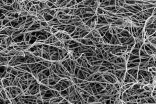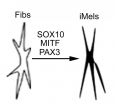INFORMATION:
Antibiotic resistance is a gut reaction
2014-12-16
(Press-News.org) Scientists from the Institute of Food Research and the University of East Anglia have discovered how certain gut bacteria can protect themselves and others in the gut from antibiotics.
The bacteria produce compounds, called cephalosporinases, which inactivate and destroy certain antibiotics such as penicillin derivatives and cephalosporins, protecting themselves and other beneficial bacteria that live in close proximity. However, they may also give protection from these antibiotics to harmful bacteria, such as Salmonella.
The gut is home to hundreds of trillions of bacteria, which have important roles in maintaining our health. But a side effect of taking antibiotics is that these may also kill off some of our beneficial gut bacteria, allowing harmful bacteria to gain a foothold and cause an infection. Susceptibility to antibiotics isn't uniform in the hundreds of species that colonise our guts, and some of the most common bacteria, the Bacteroides, are among the most resistant.
By scanning the genome of strains of Bacteroides bacteria that live in the gut, the researchers found genes that produce an enzyme called cephalospoprinase, which specifically destroys certain antibiotics. They also showed that the cephalosporinases are exported out of the bacterial cells, attached to the surface of special packages called outer membrane vesicles (OMVs).
Bacteria use OMVs to distribute compounds made inside the bacterial cells to the outside world. Among these packaged compounds are cephalosporinases that can help protect any other bacteria that are in the same environment against antibiotics such as ampicillin. This was shown by adding the cephalosporinase-containing OMVs to cultures containing the ampicillin-susceptible gut bacteria, Bifidobacteria breve, which effectively protected them against high concentrations of antibiotics. A similar test showed that Salmonella bacteria were also protected.
The researchers at IFR, which is strategically funded by the Biotechnology and Biological Sciences Research Council, now want to see whether the protection against antibiotics from gut bacteria OMVs occurs in the gut itself. If so, this would have implications for how we use antibiotics. It will also improve our understanding of the growing problem of antibiotic resistant bacteria.
ELSE PRESS RELEASES FROM THIS DATE:
Back to future with Roman architectural concrete
2014-12-16
No visit to Rome is complete without a visit to the Pantheon, Trajan's Markets, the Colosseum, or the other spectacular examples of ancient Roman concrete monuments that have stood the test of time and the elements for nearly two thousand years. A key discovery to understanding the longevity and endurance of Roman architectural concrete has been made by an international and interdisciplinary collaboration of researchers using beams of X-rays at the Advanced Light Source (ALS) of the U.S. Department of Energy (DOE)'s Lawrence Berkeley National Laboratory (Berkeley Lab).
Working ...
E-cigarettes may recruit lower risk teens to nicotine use
2014-12-16
Researchers at the Norris Cotton Cancer Center and University of Hawaii Cancer Center find that one-third of Hawaiian adolescents have tried e-cigarettes, half of whom have never used another tobacco product.
"This is a markedly different pattern of use compared to their peers in the continental U.S., where teen e-cigarette use is less than half that rate and e-cigarette users are mainly also cigarette smokers (dual-users)," reported James D. Sargent, MD, a pediatrician at Dartmouth Hitchcock's Norris Cotton Cancer Center in a paper published December 15, 2014 in the ...
Urban stream contamination increasing rapidly due to road salt
2014-12-16
Average chloride concentrations often exceed toxic levels in many northern United States streams due to the use of salt to deice winter pavement, and the frequency of these occurrences nearly doubled in two decades.
Chloride levels increased substantially in 84 percent of urban streams analyzed, according to a U.S. Geological Survey study that began as early as 1960 at some sites and ended as late as 2011. Levels were highest during the winter, but increased during all seasons over time at the northern sites, including near Milwaukee, Wisconsin; Chicago, Illinois; Denver, ...
What was the 'Paleo diet'? There was far more than one, study suggests
2014-12-16
ATLANTA--The Paleolithic diet, or caveman diet, a weight-loss craze in which people emulate the diet of plants and animals eaten by early humans during the Stone Age, gives modern calorie-counters great freedom because those ancestral diets likely differed substantially over time and space, according to researchers at Georgia State University and Kent State University.
Their findings are published in The Quarterly Review of Biology.
"Based on evidence that's been gathered over many decades, there's very little evidence that any early hominids had very specialized diets ...
Men in recovery from Ebola should wear condoms for at least 3 months
2014-12-16
Los Angeles, CA (November 16, 2014) A new article reports that despite a clear lack of research on male survivors of Ebola, the current recommended practice of waiting at least three months after recovery to have unprotected sex should be upheld. This study was published today in Reproductive Sciences, a SAGE journal.
"Our exercise demonstrated that the current recommendations to prevent the sexual spread of Ebola are based on one mere observation," the researchers wrote. "Despite the evident need to conduct more research, for now, health care professionals should strongly ...
New technology directly reprograms skin fibroblasts for a new role
2014-12-16
PHILADELPHIA - As the main component of connective tissue in the body, fibroblasts are the most common type of cell. Taking advantage of that ready availability, scientists from the Perelman School of Medicine at the University of Pennsylvania, the Wistar Institute, Boston University School of Medicine, and New Jersey Institute of Technology have discovered a way to repurpose fibroblasts into functional melanocytes, the body's pigment-producing cells. The technique has immediate and important implications for developing new cell-based treatments for skin diseases such as ...
Top blood transfusion-related complication more common than previously reported
2014-12-16
Two studies published in the January issue of Anesthesiology, the official medical journal of the American Society of Anesthesiologists® (ASA®), shed new light on the prevalence of transfusion-related acute lung injury (TRALI) and transfusion-associated circulatory overload (TACO), the number one and two leading causes of blood transfusion-related deaths in the United States. According to researchers, postoperative TRALI is significantly underreported and more common than previously thought, with an overall rate of 1.4 percent. While the rate of TACO was found ...
Targeting inflammatory pathway reduces Alzheimer's disease in mice
2014-12-16
Alzheimer's disease (AD) is the most common form of dementia and is characterized by the formation of β-amyloid plaques throughout the brain. Proteins known as chemokines regulate inflammation and the immune response. In both patients with AD and mouse AD models, the chemokine CXCL10 is found in high concentrations in the brain and may contribute to AD. A new study in the Journal of Clinical Investigation indicates that activation of the CXCL10 receptor, CXCR3, contributes to AD pathology. Using a murine model of AD, Michael Heneka and colleagues at the University ...
Microbial-induced pathway promotes nonalcoholic fatty liver disease
2014-12-16
Nonalcoholic fatty liver disease (NAFLD) is the most common liver disorder and affects approximately 1 billion people worldwide. It is not clear how this disease develops, but recent studies suggest that the bacterial population in the gut influences NAFLD. A new study in the Journal of Clinical Investigation provides a link between molecular signaling pathways in the gut, the intestinal microbiome, and development of NAFLD. Frank Gonzalez and colleagues at the National Cancer Institute found that disruption of the gut microflora prevented development of NAFLD in mice fed ...
How to treat Ebola during pregnancy
2014-12-15
A pregnant woman in Africa who has contracted Ebola is likely to suffer with a spontaneous abortion, pregnancy-related hemorrhage, or the death of her newborn. Although the risk of caring for a pregnant woman with Ebola in the United States may be rare, the Association of Women's Health, Obstetric and Neonatal Nurses (AWHONN) has published a practice brief in its Journal of Obstetric, Gynecologic, & Neonatal Nursing to guide nursing care for pregnant women and newborns.
"Nurses play a vital role in caring for patients with Ebola," said Dr. Debra Bingham, who is Vice President ...


